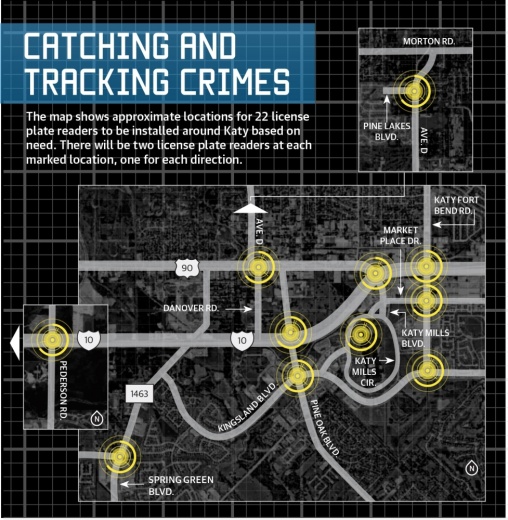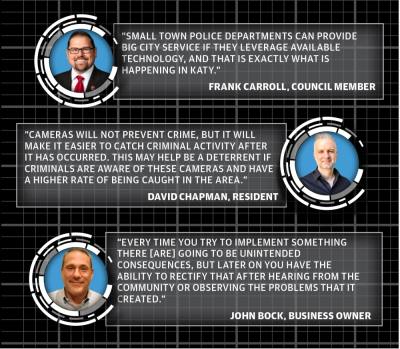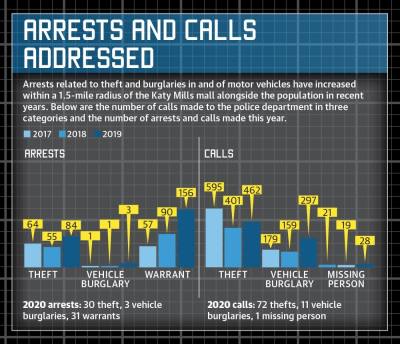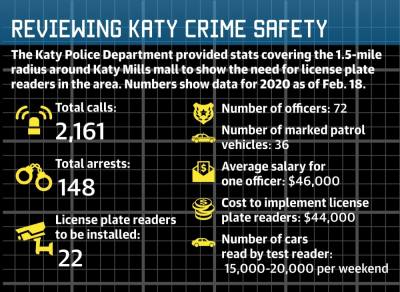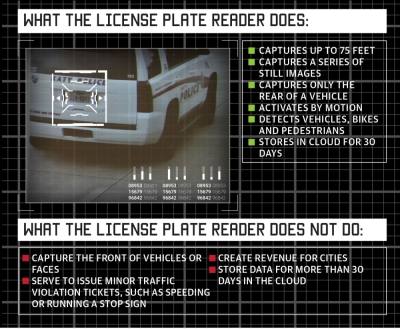In January, Katy City Council approved Diaz’s proposal to install 22 license plate readers around the Katy Mills business district and inside some neighborhoods where the department receives the most calls for service.
“A police officer can’t be everywhere at all times,” Diaz said. “They take lunch, take a day off or go on vacation. These will add a layer of security to keep the communities and the businesses a little safer.”
Although Katy is a safe community, there are some petty crimes such as car break-ins and tailgate thefts he wants to prevent, he said. The culprits behind these crimes include commuters who travel from town to town to break the law and bored teenagers, he said. So far in 2020, KPD has received 11 calls for service regarding a burglary of a motor vehicle and 72 calls to report a theft, per city data.
Joshua Miller works in public relations at Flock Safety, the Atlanta-based tech company partnering with the city to install the license plate readers. He said Diaz wants to warn ill-intentioned travelers they will get caught because the evidence will be there.
“I don’t want people to think they are not welcome here, but if you are a bad guy, don’t come,” Diaz said.
What to expect
By late April, 22 license plate readers will be situated in strategic locations based on crime and traffic trends, Diaz said.
“I think it is a wonderful investment and great tool to have,” Katy Mayor Bill Hastings said. “These are not red-light cameras. That’s what everybody seems to get confused about.”
Miller said the motion-activated license plate readers are not surveillance cameras on a constant loop. The device will capture a series of photos to store vehicle information—such as the make, model, color, plate and any aesthetic damages—as the vehicle passes by the camera. They will also capture bicycles and pedestrians. Images will then be sent to the cloud, which Katy police can access as needed.
All data will be automatically and permanently deleted after 30 days, as the types of crimes intended to be solved with the license plate readers do not require footage going back more than one month, Miller said.
“Police need the license plate to track a lead that wouldn’t necessarily be there without it,” Miller said.
The total cost for 22 license plate readers is $44,000, roughly equivalent to the salary of one officer. Each license plate reader will cost $2,000 annually, which includes installation, maintenance, solar panels and cellular data, Miller said.
The prototype license plate reader south of I-10 helped solve a significant crime less than one week after it was installed in November, Katy Police Department Detective Jerod Stewart said.
“The case is still in court, so we can’t talk about details until they prosecute the suspect at the federal level,” Stewart said. “They indicted him.”
The readers’ software will alert KPD of any vehicles associated with theft; associated with amber, silver and blue alerts; or registered to individuals with a record of violent crimes.
“If we have a crime that happens from 1 o’clock to 2 o’clock, and someone calls to say they saw a white truck, we can instantly type in ‘white truck’ in that time frame, and it will give us every white truck,” Diaz said.
Resident feedback
These license plate readers are meant to help local businesses, Diaz said. For example, 1000 Degrees Pizza Salad Wings, located at 24600 Katy Freeway, Ste. 800, Katy, has been burglarized three times since it opened three years ago, owner John Bock said. Most recently, Bock’s business was broken into on Jan. 9.
“I’m kinda for it,” Bock said of the license plate readers. “Every time you try to implement something there [are] going to be unintended consequences, but later you have the ability to rectify that after hearing from the community or observing the problems that it created.”
Council Member Frank Caroll said he supports the idea of essentially adding 22 more sets of eyes to help the police department fight crime.
“Small town police departments can provide big city service if they leverage available technology, and that is exactly what is happening in Katy,” Caroll said.
Council Member Janet Corte sought to clarify the importance of the idea at the Jan. 27 meeting.
“I understand that this brings so much value to the department that [Diaz is] willing to forgo one of [his] budgeted officers to get this system in place,” Corte said.
No officers lost their jobs to implement the new system, Diaz said adding he chose not to fill a vacancy until the next budget cycle.
Diaz said he received positive feedback from residents, though there are a few who have expressed concerns about privacy.
Resident David Chapman, who lives near the Grand Parkway and I-10, said it is common to see people checking for unlocked cars at night in surrounding neighborhoods, yet he is worried about data privacy.
“There is always the concern of the data being used for its intended purpose and citizens being made aware of when this data will be shared,” Chapman said. “How will this data be secured and guarded against hackers that may try to obtain this information illegally and for malicious intent?”
Diaz said the data collected will not be sold to third parties, and Miller said Flock Safety takes privacy seriously.
The desired effect
KPD will share data with neighboring counties and police departments to solve crimes, Diaz said.
Additionally, homeowners associations for communities such as Green Meadows, Wood Creek Reserve and Cane Island are considering installing their own neighborhood license plate readers to enhance security, Diaz said.
The HOAs plan to give the police department access to the data, which will give KPD the ability to access nearly 50 cameras total, Stewart said.
“These license plate readers will allow us to track trends and identify if an area needs more attention,” Diaz said. “We [will] develop strategies and then do targeted police enforcement as opposed to someone driving around all day with no direction.”
Hastings said he would like to see more license plate readers installed around the city and make it difficult for anyone to travel to Katy to commit a crime and remain undetected.
Ada Soto, who has been a Katy resident since 2014, said with the license plate readers and with private citizen security systems, locals can work together to identify criminals.
“I understand concerns about privacy, but something has to be done about ... petty crime before it becomes something more serious,” Soto said.
Chapman ultimately agreed.
“Cameras will not prevent crime, but it will make it easier to catch criminal activity after it has occurred,” he said. “This may help be a deterrent if criminals are aware of these cameras and have a higher rate of being caught in the area.”




